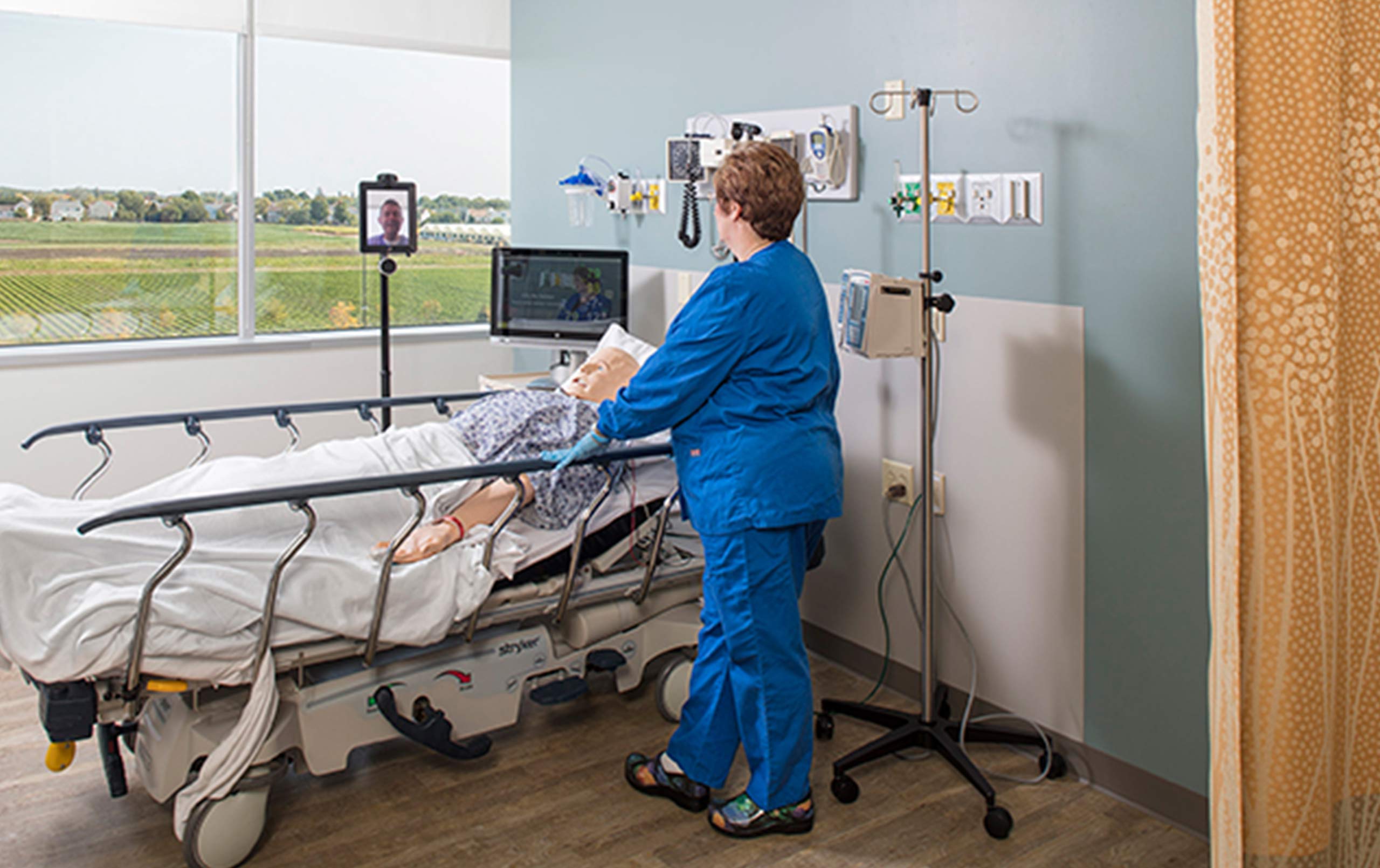
Build-out creates authentic hospital setting that expands university healthcare simulation program, brings professional training option to Centegra Health System’s Huntley, Illinois, campus.
At first glance, the upper floors of Centegra Medical Office Building 2 in Huntley, Illinois, look much like a small hospital. Sliding glass doors open to ICU, trauma, and emergency treatment rooms. Medical gas panels, gurneys, and IV stands appear throughout the space. Labor and delivery rooms have beds, seats for family members, and infant warmers.
However, some parts of the space suggest that this is not exactly a hospital. The “patients” blink, breathe, and have vital signs and voices, but some are manikins operated in adjacent control/observation rooms, while others are actors portraying a case study. The back of an ambulance is built into a wall. A simulated cadaver/autopsy table resembles a giant tablet computer. And occasionally, a robot topped with a tablet that shows a live doctor’s face rolls down the corridors and communicates with building users.
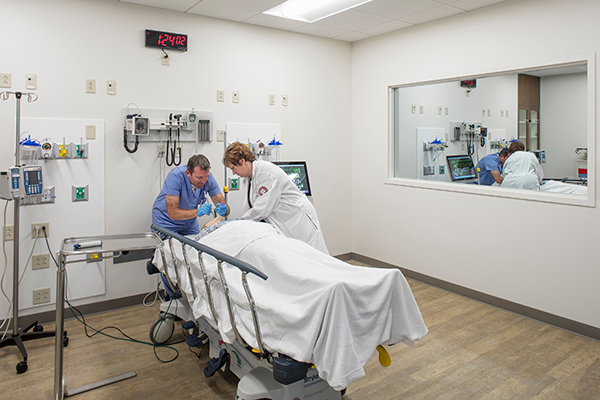
Welcome to the Rosalind Franklin University Center for Advanced Simulation in Healthcare. The 30,000-square-foot space expands Rosalind Franklin University of Medicine and Science’s (RFU) simulation services not only for its own students, but also for physicians, nurses, EMS responders, and other medical professionals seeking training. Additionally, the university hopes to use the center to build interest in healthcare professions among pre-collegiate students in the region. What a great field trip for a high school STEM class!
The center, designed by Legat Architects and built out by Power Construction, has a waiting area, offices, and a large classroom on the third floor. The fourth floor houses four simulation zones that reflect key hospital components:
- Emergency department: rooms for trauma, ICU, and treatment, as well as the simulated ambulance
- Inpatient area: rooms for adult medicine, pediatrics, and labor/delivery
- Outpatient area: waiting/reception room and exam rooms
- Surgical suite: operating room, pre/postoperative assessment, and flexible lab space
The fourth floor also includes control/observation rooms and debriefing and laboratory spaces.
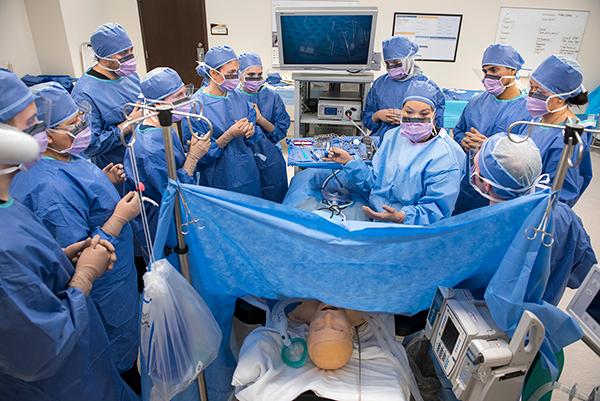
Fidelity and Realism
One of the university’s most important parameters for the Center for Advanced Simulation in Healthcare was creating an authentic healthcare environment to engage learners in realistic training and assessment.
Dr. James Carlson, RFU’s vice president for interprofessional education and simulation, has been involved with the university’s simulation program since the early 2000s. He is also often the face on the roaming robot, which he can control from anywhere, including the university’s main campus in North Chicago.
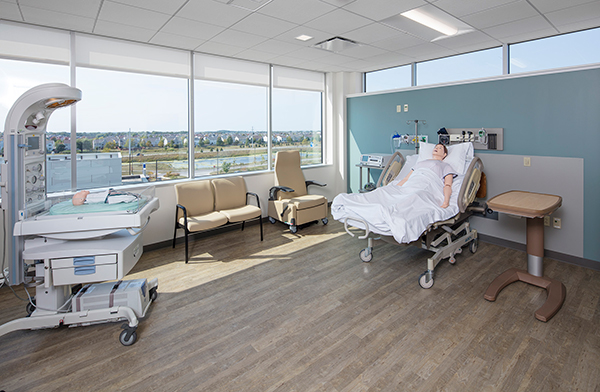
“The center gives us the fidelity to create multiple environments and engage students in simulated, but highly realistic learning activities,” said Carlson. “It’s not just a series of one-off cases, but rather an opportunity to truly immerse participants in a virtual hospital experience capable of training in nearly every element of clinical practice.”
This fidelity allows RFU to actively and authentically engage students in clinical learning earlier in their studies without risk to actual patients. For instance, the simulated operating room, outfitted with the technology and tools found in a typical OR, gives students a head start for their surgery rotations.
Carlson said, “We can orient students to their responsibilities and boundaries in the OR, so when they do get to their sites, they can safely scrub into a case and focus more on the surgical knowledge and skills they need to learn for actual patients.”
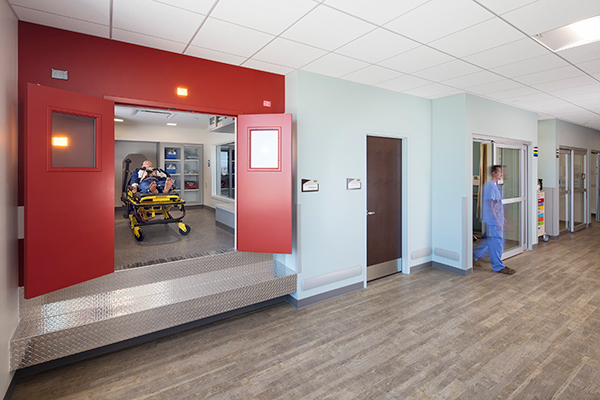
Interprofessional Education
Creating a virtual hospital with diverse simulation spaces under one roof also supports RFU’s interprofessional mission by allowing greater collaboration across various healthcare professions. The emergency department offers a strong example: the ambulance, embedded in the department, provides an opportunity to train pre-hospital providers (e.g., paramedics) in the same space as other healthcare providers (e.g., physicians, nurses, and physician assistants). Trainees practice essential teamworking skills such as communication and leadership while transitioning a patient from one provider to another. Moreover, built-in debriefing allows interprofessional teams of students to huddle and discuss decision-making around prioritizing and triaging of patient needs.
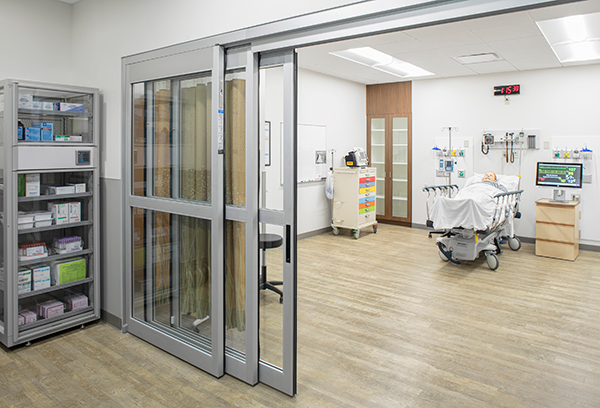
Flexibility for the Future
The Center for Advanced Simulation in Healthcare accommodates training for the current portfolio of healthcare professions. But what about the rapidly changing healthcare landscape? What if the region has different needs in the coming years? The center was designed to adapt to those changing needs.
Carlson said, “As we develop relationships with different partners, they may be thinking about new types of spaces. The center has that flexibility built in. So if, for example, we wanted to build out rehab space or an apartment for home health, we could do that.”
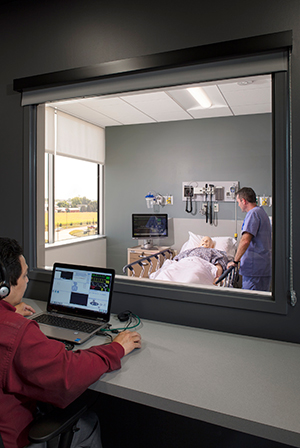
New Views
Large mirrors appear in the trauma, ICU, and operating rooms. On the other side of those mirrors are control/observation rooms where instructors control medical manikins and monitor student progress.
It is possible to see into the control/observation rooms if one gets close enough to a mirror. Therefore, Legat’s design team kept the rooms dark with black ceilings, blackout shades, and gray furniture to minimize visibility through the glass from the procedure rooms, which are much brighter.
The control/observation rooms, a first in RFU’s simulation program, have inspired leaders to rethink simulation processes at the university’s main campus in North Chicago.
Carlson said, “Completion of this project has given us a different kind of space to do our work in. This has allowed us to look at different approaches such as how we provide healthcare team training, how we use audiovisual technology as part of learning, and how we train students to use electronic health records.”
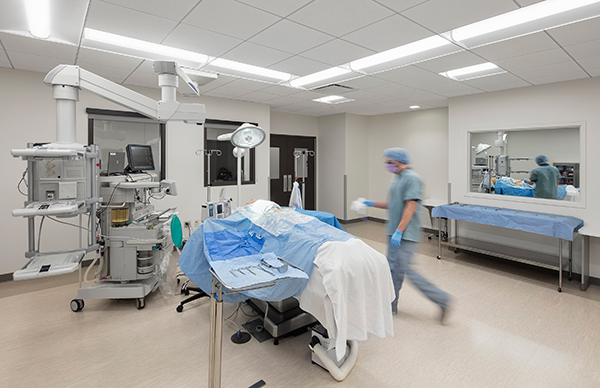
Hospital Feel, Educational Function
A key design challenge involved balancing the facility’s hospital feel with its educational function.
Derek Dunn, Legat’s project manager, said, “Since these spaces don’t have live procedures, the design did not have to adhere to strict hospital regulations.”
Dunn and team therefore bypassed some hospital requirements, enabling RFU to save construction dollars. For example, code requires an expensive, labor-intensive monolithic floor in actual surgical spaces, as well as scrubbable ceilings (typically drywall) with everything sealed and no gaps. The RFU OR uses more economical vinyl composition tile (VCT) floors and acoustic ceilings. Additionally, although headwalls in the simulation center’s patient rooms have medical gas connections, the “gases” are merely compressed air.
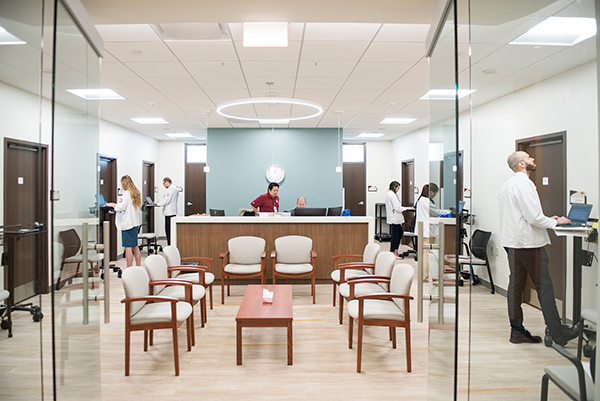
Teamwork at the Core
Teamwork drove the planning and design of the simulation center. Carlson combined more than 15 years of experience in the simulation program with feedback from colleagues in RFU’s Chicago Medical School, College of Health Professions, Dr. William M. Scholl College of Podiatric Medicine, and College of Pharmacy to work with the design team throughout the project.
Legat’s healthcare and higher education segments also collaborated. The former focused on function, size, and layout of the simulation spaces; the higher education team designed the large classroom on the third floor, while also orchestrating budget and schedule.
Bob Jackson, RFU’s director of facilities management, said, “The efforts and team approach between Legat Architects, Power Construction, and RFU resulted in a build-out recognized with great praise by all members of RFU involved.”
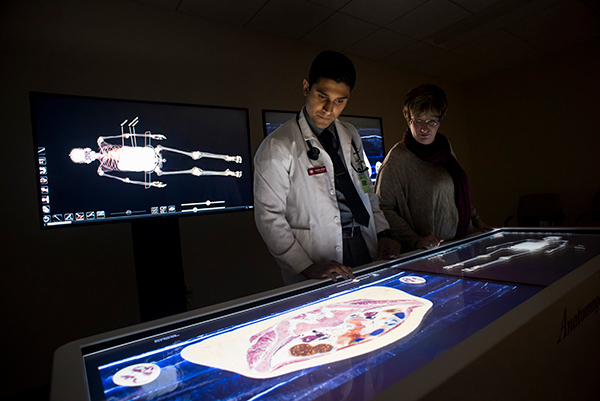
Regional Partnerships
A major reason that RFU located its simulation center on the Centegra Health System Huntley campus (rather than on the university’s main campus) was to build partnerships with local healthcare providers. That has proven to be a wise decision.
Carlson said, “We’ve had some early successes in collaborating with our regional partners.”
For instance, RFU has worked with Centegra’s nursing education department to help with training and onboarding of staff, particularly with obstetrics and critical care. Additionally, the center recently welcomed regional physicians for professional development activities focused on new ultrasound techniques. These activities used state-of-the-art simulation technology built into the learning environment.
The university anticipates that these partnerships will continue to grow in the coming years.
It’s a logical conclusion — the Center for Advanced Simulation in Healthcare offers clinicians an immersive environment to practice clinical skills, plus faculty from a national leader in interprofessional medical and healthcare education and research.
Contact us to learn more about medical simulation design, or comment below to share your thoughts on this post.


